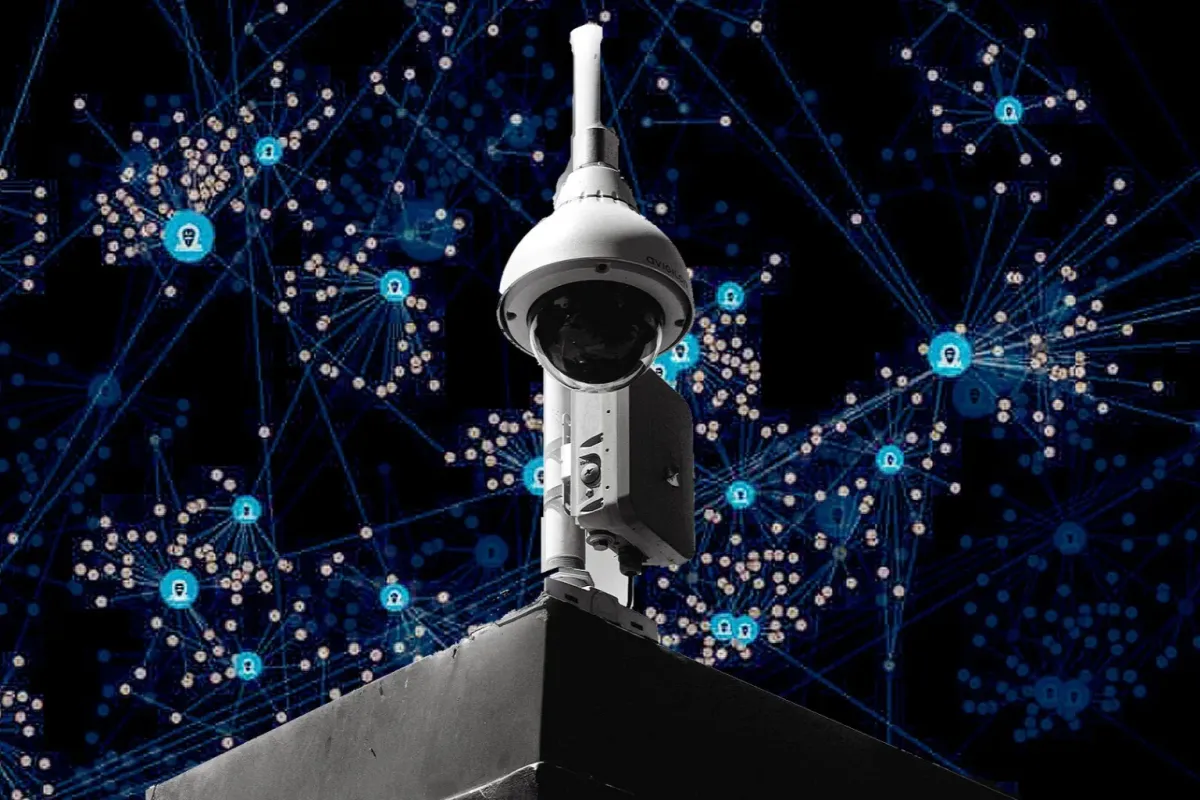
LAPD has bolstered its online surveillance operations by adding another piece of technology to its roster. LAPD’s newest surveillance partner, Cobwebs Technologies, gathers data from your phone and social media activity and turns it into intelligence. The Israeli company’s surveillance software, which outsources much of their surveillance work to AI and machine learning, gives police warrantless access to your personal information.
Cobwebs Technologies was founded in 2015 by former IDF special operatives Omri Timianker, Shay Attias, and former Mossad official Udi Levy. The company is part of the controversial billion-dollar surveillance industry in Israel, where the technology is often tested on Palestinians before being implemented elsewhere in the world. During a 2014 trip to Israel, LAPD’s top brass saw firsthand how Israel used drones, social media surveillance software, and automatic license plate readers. Within five years of the trip, the department would be using all three. This year, Cobwebs was acquired by private equity firm Spire Capital, which owns the surveillance companies GeoTime and PenLink. The company currently has several contracts with local and federal agencies including the Texas Department of Public Safety (who use it to track migrants), the IRS, and the Department of Homeland Security.
LAPD purchased the nearly $200,000-per-year subscription to the technology in 2022 with the help of a $600,000 DHS grant that focuses on terrorism prevention in urban areas. Part of the purchase was a suite of over 50 digital tools, including surveillance and investigative software built by other companies. In the grant proposal for the technology, LAPD said it would make it easier to share intelligence with federal police agencies.
Meta, the company behind Facebook, Instagram, and WhatsApp, banned accounts used by Cobwebs and labeled it a surveillance-for-hire company. In a 2021 report, Meta found that Cobwebs was being used to target activists, opposition politicians, and government officials in Hong Kong and Mexico. The report pushes back against the surveillance company’s claims that it tracks only criminals and terrorists.
Social Media Monitoring and Data-Driven Profiling
It is not news that LAPD monitors your social media and surveils your online activity. It is also not news that your phone and computer are doing the same, sending you targeted ads based on the links you click and apps you use. Cobwebs can combine all of this data and turn it into intelligence for police with the help of two platforms: Tangles and Webloc.
Tangles is Cobwebs’ marquee platform. It uses AI and machine learning to automate its surveillance capabilities. The software’s AI is continually searching, scraping, and extracting information from the public’s online activity. This includes monitoring geotags of geographic locations, social media posts, and online communities, including those on the dark web.
Tangles allows police to create extremely detailed dossiers on people, either targeted by police or found by Cobwebs while scraping personal and online data. Per the company’s promotion material, the information it provides to police includes “locations, context, internal relations, group structures, [and] hierarchies,” as well as the influence of the target’s “social communities.” This data-driven profiling, as Cobwebs describes it, can infer a person’s social network, whether they are “likely perpetrators of violence,” and monitor changes in a person’s sentiment. Cobwebs says it can help police “prevent events before they occur.”
Cobwebs’ AI can also profile a person by using its deep image analysis to make “connections” the company claims are “invisible to the naked eye.” The software scans photos and videos to find connections in people’s faces and intentions in text and labels within those photos, labeling anything it deems suspicious. Cobwebs doesn’t elaborate on what connections the software makes or how it can assert intentions from an image.
In a case study, Cobwebs demonstrated how the software could’ve been used to prevent the Alexandria shooting in 2017. The company pointed to how police missed the intentions in the shooter’s social media posts, claiming their AI would have been aware of them: “It can take more than the human mind to comprehend complex situations, especially when it comes to taking available information into consideration within context.”
However, there can be real harm in police departments buying in on artificial intelligence and predictive analysis technologies that may be nothing more than buzzwords. Dave Maass with the Electronic Frontier Foundation, a nonprofit organization dedicated to protecting civil liberties in the digital world, says that “when an algorithm ‘underperforms’ or ‘fails to meet expectations,’ that could mean that innocent people are being harmed by faulty technology.”
The use of data-driven policing software relies on a technology known to be rife with bias and inaccuracies. Multiple studies have shown that the algorithms used in AI predictive policing models are racist and inaccurate. Making matters worse are the shadowy algorithms and calculations used by Cobwebs. Since they’re proprietary, they aren’t accessible to the public, making it difficult to independently review them for bias or the use of bad data.
LAPD has previously used technology for predictive policing, including both Palantir and PredPol, which has led to the over-policing of Black and brown communities in Los Angeles. Their marquee predictive policing program to reduce gun violence, Operation Laser, was shut down in 2019 after internal audits found inconsistencies in its use. The department now uses “data-informed community-focused policing,” which activists and community organizers have pointed out is predictive policing by another name.
Monitoring Protests and Civil Unrest Is the Biggest Selling Point for Police Departments

Cobwebs shared a presentation with LAPD, “Civil Disorder Investigation Methodology,” but LAPD’s gratuitous redactions of the version Knock LA obtained make it illegible and thus impossible to understand the exact content of the company’s pitch. There are references to creating target cards for specific people and organizing them using tags. The sources the software continuously scans to “reach more tactical information” are redacted by the department.
More illuminating is a case study created by Cobwebs that shares how invasive the software is when it comes to surveilling protests. Before a big soccer game in Europe, police monitored social media using alerts for keywords and hashtags to find specific soccer fans “who are most likely to cause trouble.” From there, the software uploads a person’s photograph and creates a target card, allowing police to track them in real time, online or in person.
Knock LA requested a list of keywords and hashtags used in Cobwebs by LAPD. However, the department refused to disclose the list, citing an exemption that protects confidential records used in active investigations from being shared with the public. If the past is any sign of what the hashtags or keywords might be, previous reporting by the Brennan Center for Justice revealed that in 2020 LAPD surveilled Black Lives Matter protests on social media using hashtags like #antifa or #acab. LAPD even followed three specific Twitter accounts, including one that tweeted out information coming from police scanners about the protests.

Buying Their Way Around the Fourth Amendment
Webloc, the other tool included in the department’s Cobwebs subscription, is the most invasive one. The application gives police warrantless access to anyone’s phone data. The software allows police to track where people have been, collect demographic data from their apps, and visualize it on a map.
The software can do this thanks to the “billions of data points” continuously harvested for their users to access. Those data points include detailed information about people not suspected of any crimes. This data can be obtained easily from data brokers and provide far more detailed information about a person’s life than the cell site location data police normally request. The data available through Webloc includes mobile advertising IDs from apps a person uses and other personal information including the gender, age, religion, and interests of the phone user. Webloc says it uses that data, along with their location, to create a “threat actor analysis.”
This data can also be geofenced, allowing police to search a specific location on a map during a specific timeframe and gather phone data from everyone in that area. Those maps can track a person at a protest or share a person’s location data with agencies in other states.

The department claimed it gets search warrants before accessing phone data and does not use Webloc to geofence, but there are ways to use the information without a warrant. One of the ways is outlined in a 2021 report by the Center for Democracy and Technology that highlights how governments and police departments can, through a loophole in the Electronic Communications Privacy Act, access phone data without a warrant so long as it’s done through a data broker. Another way is through the common practice of parallel construction, where police can gather evidence in a way that violates the Fourth Amendment but hide how they got the information — by fabricating or finding a different source.
‘Ensuring the Public Is Informed’
LAPD’s largest bulk purchase of surveillance technology happened right before the passage of the department’s Acquisition and Annual Reporting of Certain Information Systems and Technologies policy. The bulk purchase of $600,000 worth of surveillance and investigative technology included payment to Cobwebs Technologies. LAPD passed the policy on August 17, 2022, and promoted it to ensure the public is informed about the technology it uses.
The department’s policy requires an application be filled out before acquiring new surveillance technology. That application must be submitted and discussed publicly at the Board of Police Commissioners meeting. The report outlines “an impact on individual privacy rights, civil liberties, or other constitutional rights.” The application also outlines the types of data collected, oversight policies, and plans to safeguard people’s rights. Eight pieces of surveillance software bought in the bulk purchase escaped this application process.
Another part of the policy states there must be periodic audits of the surveillance technology the department uses — in a Comprehensive Technology Audit. The audit includes technologies currently being used or implemented after the policy’s passage. Missing from the first technology audit since the new policy went into effect was Cobwebs Technologies.
When asked about this exclusion, the department said that at the time of the report’s creation in October 2022, they had used the software for only two months and felt its addition to the audit would not have provided a “substantive analysis” of the software’s use. Only two of the eight applicable surveillance programs the department bulk purchased with the USAI grant have been audited.
After an entire year of use, the department said that Cobwebs tech will be audited internally and presented to the Board of Police Commissioners in the first quarter of next year.
While LAPD remains enamored with the capabilities of today’s surveillance software, its policies have not kept up with the speed of advancements in technology. For example, the department lacks a policy on accessing and tracking people’s phone data through a third party and/or data brokers. It also lacks a policy about using technology that uses AI or machine learning, including whether the algorithms in the software it uses are aligned with the department’s biased policing policies.
LAPD defends using Cobwebs, saying the information it gathers is open-source and publicly available. But Cobwebs is not available for use by the general public, nor does the general public have access to the breadth of information gathered by Cobwebs.
Dave Maass with EFF pushes back against LAPD’s claim:
“LAPD likes to play games and claims that if it’s public, there is no public interest in protecting it from police spying. … LAPD should learn from history and recognize that this kind of surveillance is damaging to everyone.”
